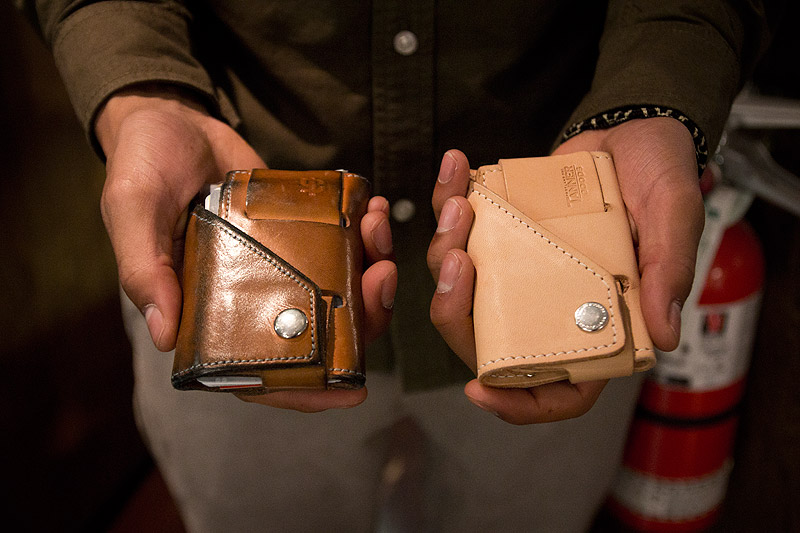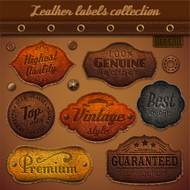What are the different types of leather?
Posted by Daniel Sutton on Apr 13th 2014
It’s time for a little leather one-o-one. Say you’re shopping around for some decent cowhide, and you want to know what leather grain's best for you. Is this leather going to stain easily? How durable is it? What’s all this about a patina? We’ll break it down for you.
Lest you forget, leather comes from the skin of an animal, usually a cow. This skin, when removed from the animal, is identified by layer, and these layers determine the quality of the leather you’ve got. There are four primary types of leather grains.
Full Grain
When somebody tells you that their item is made from full grain leather, it means that you’re dealing with hide that hasn’t been buffed or snuffed or sanded, and is the thickest type of leather out there. Consequently, it will possess all the same natural scars and spots the cow collected foraging through thorny thickets and barbed wire fences. Many people actually prefer this, as firstly, it tells a story. Second, it keeps the leather in its most natural form, and is stronger. The grain (the building block of your leather valuable) is still very much intact, preserving much of the durability the hide might have had while it was chilling on top of a living cow. The grain’s also got a bit more breathability, meaning it’ll absorb more moisture. Apart from all this, it’ll also develop a patina over time. A patina is a golden or dark brown-ish sheen that develops over time on natural leathers as they meet regular treatment and/or at exposed to the elements. All the sunlight, humidity, oils and liquids and all other foreign objects start to leave their mark on the leather. This may sound bad, but many people actually prefer it, and some will go to lengths to milk their bag into growing a patina early. It’s kind of like fine wine. You don’t want to drink milk that’s been sitting around for ten years. But wine, as with leather, can grow finer with age, if treated right. Take a look below for yourself to see what I’m talking about.

Know Your Leather Grains
Full grain leather usually comes in two varieties: Aniline and semi-aniline. If you don’t know what this means, check out our blog “How to Identify Types of Leather.” As with many other types of leather, it can also finished with a protective layer, or unfinished. One indication that your leather is finished is that water will bead on top of its surface, rather than darkening it, like you will encounter with unfinished leather. Read more about this in our blog "Leather Care for Finished and Unfinished Leather Furniture." Other than that, you'll be safe knowing that full grain will be the richest, highest quality leather money can buy.
Top Grain
Top grain is what happens when leather is sanded to remove the split layer, separating it from the full grain to remove all the natural scarring. Whatever markings remain are covered or corrected before the color is applied, so you won’t be getting any pesky skin art the cow left behind. Because the strongest layer has been removed, the leather is more thin and pliable than full grain. Like full grain, top grain can be finished or unfinished (with unfinished hide darkening when wet), but a finished coat is usually added to give the item a more uniform appearance and protect it from the elements. Like full grain, top grain may also develop a soft patina over time. The downside is that this coat also gives the leather a plastic-like texture with less breathability and durability. On the plus side, top grain stains far less easily than full grain, and generally costs a bit less. For this reason, most furniture you’ll find will be top grain, as full grain is generally too thick for furniture application. Top grain is considered the second highest quality leather, right below full grain.
Genuine Leather
Running third place on the most efficient forms of leather, genuine leather is the stuff left over after the top hide is split off for higher grades. To give the leather a more even surface, it’s usually refinished, adding a pigment or artificial grains to simulate the real thing. This approach is often used to correct excessive scarring, but it lacks the strength and visage of higher grade leather. Suede is often a product of genuine leather.
Bonded Leather
Bonded Leather is created by bonding leftovers from organic leather and polyurethane binders to a fiber sheet. Although economically priced, it is considered very cheap, as it is essentially using leather that was completely ground into dust that has lost most of its original form. It is much weaker than full and top grain leather.
So, there are your four major leather grains. While most of your leather products are going to be cow, exotic forms also exist, and with these exotic textures, the strength and color longevity of all these leather grains may differ, and each has their own unique strengths. We know pigskin as the notorious master of all things football, and lambskin possesses a uniquely soft texture many people prefer for gloves. Check out our blog “Cleaning and Conditioning Exotic Leather” for more information on that.
Now that you’re a wizard on all things leather, keep this terminology in mind. Knowing what leather grains are out there will be invaluable for snagging a good price and keeping that new lucky messenger lucky for a long time. Depending on the breathability and protective layer of your leather, some conditioners may be well or ill suited for it. As always, try your leather conditioner in a discreet area and observe its effects before applying it to the entire item.
If you've still got an appetite for more leather 101, here's a handy resource straight from the Leather Man of Saddleback Leather himself - Dave Munson! Cheers, everyone!
Contributors
Anna Woodward
Daniel Sutton
Chris Repp (www.leatherhelp.com)

